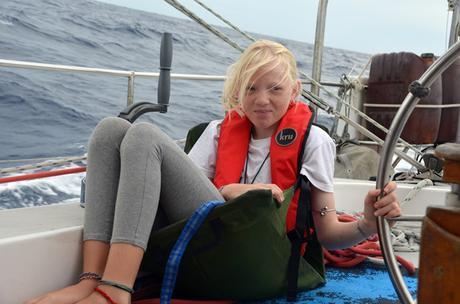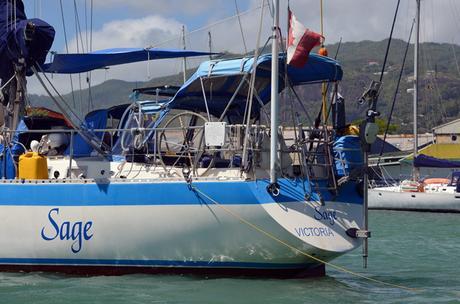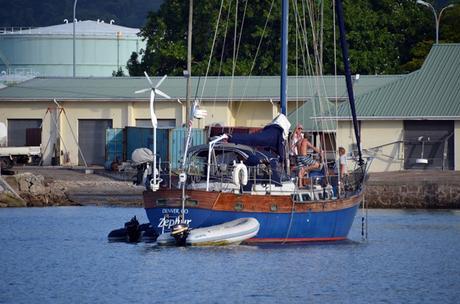 Autopilot? Windvane? Both, or hard-core hand-steering? Problems with our autopilot have caused some headaches on Totem. So why don’t we have a windvane for self-steering, instead of relying only on an autopilot?
Autopilot? Windvane? Both, or hard-core hand-steering? Problems with our autopilot have caused some headaches on Totem. So why don’t we have a windvane for self-steering, instead of relying only on an autopilot?
There are a lot of reasons to add a windvane. They don’t need any power, whereas running the autopilot 24×7 on longer passages sucks a fair bit of from the battery bank. A mechanical windvane has fewer moving bits to break down, and no finicky electronics.
We took a hard look at windvanes before we took off in 2008, and were biased to add one to Totem. But like EVERYTHING on a boat, it involved a set of compromises. In our case, as much as we really wanted to employ green-powered-self-steering, the compromises ultimately didn’t add up.
We’re a bit too big
Totem’s displacement (20 gross tons) pushes the top end of the range for vane designs. Because of Totem’s size, setup would require us to use our boat’s rudder in addition to the windvane rudder. That means we would have to lead lines to our wheel. Because Totem has a center cockpit, lines would spiderweb the aft deck, across the cockpit combing, etc. Clean decks are safe decks, so this is pretty unappealing. Of all the reasons we didn’t end up with a windvane on Totem, this was the kicker.

Vane setup on the 38′ Wauquiez, Sage
You need the right conditions
A windvane is awesome in the right conditions, but needs, well, WIND! Around the equator are calms and squalls, not steady trade wind breezes, and around the equator is where we’ve spent most of our time the last few years. Between late 2012 and early 2015- basically, from Papua New Guinea through Asia- we did a lot of motoring on passages. Those motoring miles would have to be hand-steered if we didn’t have an autopilot. The alternative is to sail different routes (I can’t imagine skipping PNG, our most memorable cruising destination), or much longer passages (which introduces safety questions), or cut back / skip regions (but we loved Southeast Asia!) to stick with the trade winds. Again, compromises, and they’re fine for some boats- just, not us.
Windvanes break down, too
They are mechanically simpler, but that doesn’t make them infallible. Our last boat, a Hallberg-Rassy 352, had an Ares windvane; the prior owner had installed it in anticipation of a circumnavigation that never happened. We were excited to get familiar with this piece of cruising gear, since the HR was our practice boat to learn systems before taking off on our own adventures and we were biased towards windvanes.
Over the four-ish years we had the boat, we didn’t use it once. At the time, our weekend/holiday style sailing involved day hops instead of passages; those shorter transits typically included many changes apparent wind direction. Getting a windvane set can involve a lot of tweaks and adjustments…easy for longer passages, inconvenient on short jaunts…especially while juggling a herd of small children. Probably in part from lack of use, it started having some pretty ugly looking corrosion problems.

Zephyr makes it work on their heavy 48 footer
Windvanes cost how much?
We never planned to forgo an autopilot; the windvane would be additional equipment. Looking at the cost to add one, other concerns aside, we felt our money was better spent on backups / redundancy for the autopilot instead of an additional system.
The Monitor windvane considered for Totem starts at just under US$5,000. It would require a special mount to accommodate our transom shape- over $2,000 more. Want to use it as an emergency rudder (another arguably great reason for a windvane)? That conversion kit runs about $1,500. And then, you have to install it- are you adding labor costs or doing it yourself? Basic hardware is now nearly $9,000- taxes? Shipping? Labor? Spare parts? Upfront costs are just one part of the picture, but this “free power” system just got pretty expensive.
Don’t let me give the wrong impression
I think I need to clarify: I think windvanes are an amazing tool! I wish it did make sense for us to have on one: we try to live with as light a footprint as we can, and the lure of wind-powered self-steering is strong. But everything on a boat is a compromise, and for the reasons above, it didn’t make sense to add the windvane to Totem. Another time, another boat, we’d happily consider adding one to the transom.
This post is syndicated on SAILfeed.

